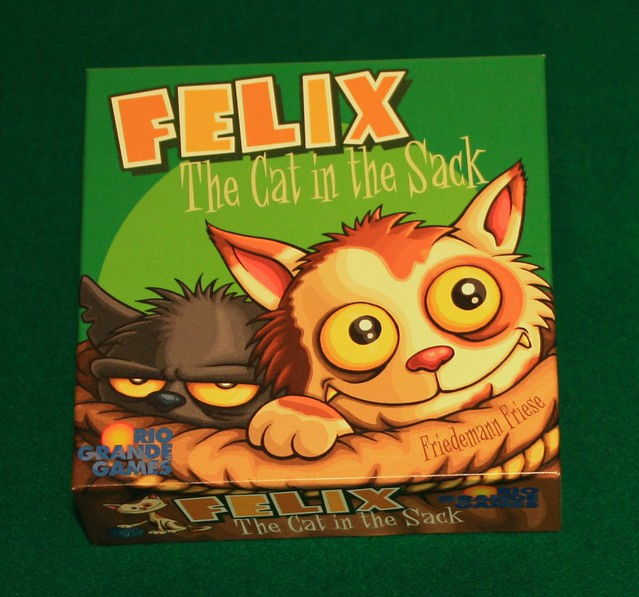
Played Felix The Cat In The Sack last night once again and I remain just as enamored with this clever take on hidden information in an auction.
In the game, each player has an identical hand of cats with point values ranging from the negatives to positives, plus some dogs. During setup, one random card is removed from each player's hand. Each turn, players offer one card face-down from their hand for auction then place bids on the lot. One card is revealed to start the round of bidding. Each time a player passes, she takes a small compensatory reward and reveals one more card. The little dog removes the lowest cat in the lot. The big dog removes the highest cat in the lot. Two or more dogs remove each other from the lot.
The thing I love is how information gradually gets revealed while also raising the stakes. In time you may realize you've overbid on a real stinker of a lot. If you put down a high-value cat in the lot, you may also find yourself simply bidding more than that cat is worth, simply to keep another player from taking it. Very much a dollar auction experience, all with cute cats and doggies.
The auction genre is one I haven't yet cracked, but not for lack of trying. You may recall last year I was tinkering with a wine collection auction game. That had some issues with card-counting and somewhat complicated role-selection mechanics shoe-horned in. If I were to take that game and refine it with Felix's mechanics, it may look something like this.
Schrödinger's Cabernet
Players are wine collectors putting their own bottles up for auction. Some bottles are fraudulent counterfeits, but this is only confirmed once the bottle is open.
Stuff Needed
- Cards: Bottles are represented by cards. The face shows a bottle and its actual value. The back shows a potential value range. Each player starts with an identical hand of cards, minus one randomly removed from play.
- Claim Markers: One unique marker for each player. Perhaps a cork?
- Bidding Chips: Each player starts with fifteen.
Round Start
Oldest player starts, turns continue clockwise around the table.
Each player places one card face-down in the middle of the table forming the lot for auction. Based on the back of the cards, players know the potential value of the lot, but can’t be absolutely sure.
Then each player takes turns placing bids, trying to win the whole lot.
The first player to state "Pass," removes herself from the auction and instead puts a claim marker on the highest bid on the table.
The next player to pass puts a claim marker on the second highest unclaimed bid.
Bidding continues until all but one player has passed.
This remaining player does not earn anyone else's bid. Instead, she wins the lot and sets it aside in her collection. Players do not yet know the true value of their collections.
All other players collect the bids to which they've laid claim.
To earn some quick cash, a player may "open a bottle" at any time and reveal one card from her collection to all players. She earns that card's value in chips. That card is then removed from the game.
The new round begins with a new lot up for auction.
Endgame
The game ends when the last lot has been auctioned off. Then players reveal their collections. Total the value of each player's collection plus each chip. The player with the highest total wins.
No comments:
Post a Comment